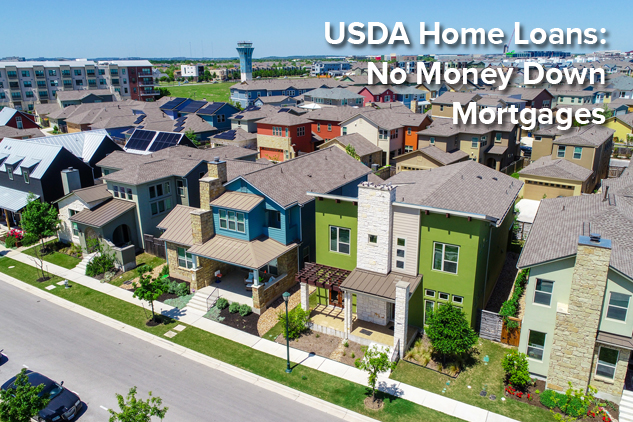 A USDA loan (Section 502) is a home loan that is guaranteed by the United States Department of Agriculture. It offers very low and competitive interest rates on home loans to borrowers with no down payment requirements. The USDA Home Loan Program was made available to borrowers with excellent financing terms and flexible credit guidelines to give people an incentive to populate rural areas.
A USDA loan (Section 502) is a home loan that is guaranteed by the United States Department of Agriculture. It offers very low and competitive interest rates on home loans to borrowers with no down payment requirements. The USDA Home Loan Program was made available to borrowers with excellent financing terms and flexible credit guidelines to give people an incentive to populate rural areas.
Since the USDA Loan offers 100% financing to buyers and closing costs can be paid by seller or rolled into the loan, homebuyers usually do not have to bring any funds to closing! This program is available in the gold standard of home loans, a 30 year fixed rate mortgage with no prepayment penalties. The terms of a USDA Home Loan are so attractive that rural areas are populating rapidly. Go to USDA Home Loan Comparison to see how the USDA Home Loan stands against other home loan products.
 There are a few requirements that must be met to be eligible for a USDA Home Loan. Go to USDA Home Loan Requirements to review these in more detail.
There are a few requirements that must be met to be eligible for a USDA Home Loan. Go to USDA Home Loan Requirements to review these in more detail.
For the last 80 years, The United States Department of Agriculture (USDA) has been at the forefront of developing rural America.
On April 30, 1935, President Franklin D. Roosevelt signed Executive Order 7027 which established the Resettlement Administration (what we know today as USDA Rural Development). During the Great Depression, this Administration provided aid to destitute families by helping them relocate. They also restored soil to eroded areas and issued emergency loans to farmers.
Over time, congress continued to expand the role of the Resettlement Administration. On October 13, 1994, congress reorganized the Resettlement Administration under the Federal Crop Insurance Reform and Department of Agriculture Reorganization Act. Under this Act, the USDA Rural Development Department was created to administer the USDA Home Loan Program for rural housing.
The USDA Home Loan Program has roots into the soil of America back to the days of the Great Depression and is 100% committed to helping improve the quality of life in Rural America. Since its inception, this organization has been helping people live better and still is to this day by continuing to offer you the USDA Home Loan
Go to USDA Loan Comparisons to see how this program compares with other government and conventional loan products.



 Unlike other loan programs, the USDA home loan imposes a cap on the total cumulative income earned by all members of a household. Income for each member of the household is taken into consideration into the USDA income cap even if the members of the household are not on the loan. The income of other household members that are not on the loan will not be taken into consideration for debt to income ratio qualification purposes; however, it will be counted in the USDA income cap. Income information and documentation will need to be provided on any member of the household that is currently working even if they are not on the USDA home loan.
Unlike other loan programs, the USDA home loan imposes a cap on the total cumulative income earned by all members of a household. Income for each member of the household is taken into consideration into the USDA income cap even if the members of the household are not on the loan. The income of other household members that are not on the loan will not be taken into consideration for debt to income ratio qualification purposes; however, it will be counted in the USDA income cap. Income information and documentation will need to be provided on any member of the household that is currently working even if they are not on the USDA home loan. An appraisal is required on any home loan purchase transaction to show the current market value of the property. With a USDA home loan, the appraisal is ordered through an appraisal management company that locates an appraiser to go out and appraise the property.
An appraisal is required on any home loan purchase transaction to show the current market value of the property. With a USDA home loan, the appraisal is ordered through an appraisal management company that locates an appraiser to go out and appraise the property. All utilities to the property need to be on when the appraiser goes out to complete the visual inspection. If the utilities are not on, the appraiser is not able to test the electrical and mechanical systems to ensure they are functioning properly and will need to go back out for a final inspection once the utilities are turned on. Most appraisers will charge the homebuyer an additional fee ranging from $100-$150 for the final inspection so it is very important to check with your realtor and/or seller to verify all utilities are on prior to the appraisal inspection.
All utilities to the property need to be on when the appraiser goes out to complete the visual inspection. If the utilities are not on, the appraiser is not able to test the electrical and mechanical systems to ensure they are functioning properly and will need to go back out for a final inspection once the utilities are turned on. Most appraisers will charge the homebuyer an additional fee ranging from $100-$150 for the final inspection so it is very important to check with your realtor and/or seller to verify all utilities are on prior to the appraisal inspection.